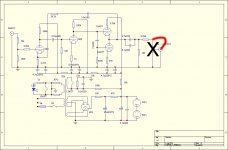As a general rule, the output impedance of something should be significantly lower than the input impedance of whatever follows. You certainly want to avoid a 'match'. A factor of a hundred is big enough, but the exact value is not critical. For example, a preamp with 500ohms output could drive inputs down to about 20K.
DF96,
if i remove the potentiometer from the and connect the 9,09 K to the output
the amp goes in protection. what i'm doing wrong
if i remove the potentiometer from the and connect the 9,09 K to the output
the amp goes in protection. what i'm doing wrong
The switch-on transient at the output will now be bigger and longer. Bigger because it is no longer attenuated by the volume control. Longer because the RC time constant is now set by the 1M resistor rather than the 22K pot. Swap the 1M for something like 100K (value not critical), but still let the line stage warm up before switching on the main amp. You could also use a slightly smaller output capacitor 1uF instead of 4.7uF.
The full solution for this issue is to add a time-delay relay to short the outputs when the line stage is first switched on.
The full solution for this issue is to add a time-delay relay to short the outputs when the line stage is first switched on.
Hi,
The DC blocking cap on the output of the single supply stage has to charge up from zero volts to ~half rail voltage. This charging current has to come from somewhere. If the power amp input is the path of least resistance then the cap sucks DC current through the Power amp input.
Add a mute to the amplifier inputs.
The same mute could be wired to the source outputs. This is probably the better location since it is the topology of the source that is the cause of the problem, solve it in the source.
The mute can be a signal relay or a jFET. Both delayed with a AC power detector/cap.
BUT !
make sure the output stage cannot be damaged by the mute, which is a short from signal to ground.
The DC blocking cap on the output of the single supply stage has to charge up from zero volts to ~half rail voltage. This charging current has to come from somewhere. If the power amp input is the path of least resistance then the cap sucks DC current through the Power amp input.
Add a mute to the amplifier inputs.
The same mute could be wired to the source outputs. This is probably the better location since it is the topology of the source that is the cause of the problem, solve it in the source.
The mute can be a signal relay or a jFET. Both delayed with a AC power detector/cap.
BUT !
make sure the output stage cannot be damaged by the mute, which is a short from signal to ground.
Last edited:
- Status
- Not open for further replies.
- Home
- Source & Line
- Analog Line Level
- preamp
